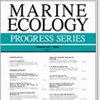根据椎骨环分析确定的不同产地证实了太平洋蓝鳍金枪鱼在北太平洋的洄游模式
IF 2.1
3区 环境科学与生态学
Q2 ECOLOGY
引用次数: 0
摘要
摘要:太平洋蓝鳍金枪鱼(PBF)有两个主要产卵场,在北太平洋广泛洄游。为了了解其种群结构和洄游生态,我们分析了从不同年龄和地区收集到的脊椎样本,然后根据脊椎形成后变化不大的第一个环面估计其产地。在所有采样区域和年龄组中,都观察到了琵琶鱼的两个产卵组,包括来自日本海(归为 SJ 组)和来自琉球群岛和台湾附近海域(RT 组)的鱼。在较年轻的年龄组中,SJ 组的百分比在日本附近较高,而 RT 组的百分比在东太平洋(EPO)较高。当它们迁移到东太平洋时,RT 组在日本附近的百分比会降低,而当它们返回时,其百分比又会升高。这些结果表明,不同的产卵区域有不同的洄游模式。有趣的是,这些结果表明,来自东大埔的鱼类很少洄游到日本海。在所有采样区域,10龄以上鱼群RT的百分比相似且更高,这些百分比被认为是2个产地相对贡献的最终百分比。这是一种有用的方法,使我们能够很容易地研究这两个产卵场在不同时间和空间的相对贡献,从而根据种群组成的变化深入了解环太平洋洄游的动态。本文章由计算机程序翻译,如有差异,请以英文原文为准。
Distinct natal origins based on vertebral ring analysis corroborate the migration pattern of Pacific bluefin tuna in the North Pacific Ocean
ABSTRACT: Pacific bluefin tuna (PBF) Thunnus orientalis have 2 major spawning grounds and migrate widely in the North Pacific Ocean. To understand the population structure and migratory ecology, we analyzed vertebral samples collected from a wide range of ages and areas and then estimated their natal ground from the first annulus in the vertebra, which does not change significantly after formation. Both spawning groups of PBF, including fish that originated from the Sea of Japan (assigned as group SJ) and from the waters around the Ryukyu Archipelago and Taiwan (group RT), were observed in all sampling areas and age classes. In younger age classes, the percentages of group SJ were higher around Japan, whereas those of group RT were higher in the eastern Pacific Ocean (EPO). The percentage of group RT decreases around Japan as they migrate to the EPO and then increases when they return. These results suggest a tendency toward different migration patterns depending on the natal area. Interestingly, the results suggest that fish from the EPO rarely migrate to the Sea of Japan. The percentages of group RT for age 10+ were similar and higher in all sampling areas, and these are considered to be the final percentages of the relative contribution of the 2 natal grounds. This is a useful approach that enables us to easily examine the relative contribution of the 2 spawning grounds across time and space, providing insights into the dynamics of movement around the Pacific based on variations in the population composition.
求助全文
通过发布文献求助,成功后即可免费获取论文全文。
去求助
来源期刊

Marine Ecology Progress Series
环境科学-海洋学
CiteScore
5.30
自引率
8.00%
发文量
238
审稿时长
3 months
期刊介绍:
The leading journal in its field, MEPS covers all aspects of marine ecology, fundamental and applied. Topics covered include microbiology, botany, zoology, ecosystem research, biological oceanography, ecological aspects of fisheries and aquaculture, pollution, environmental protection, conservation, and resource management.
 求助内容:
求助内容: 应助结果提醒方式:
应助结果提醒方式:


